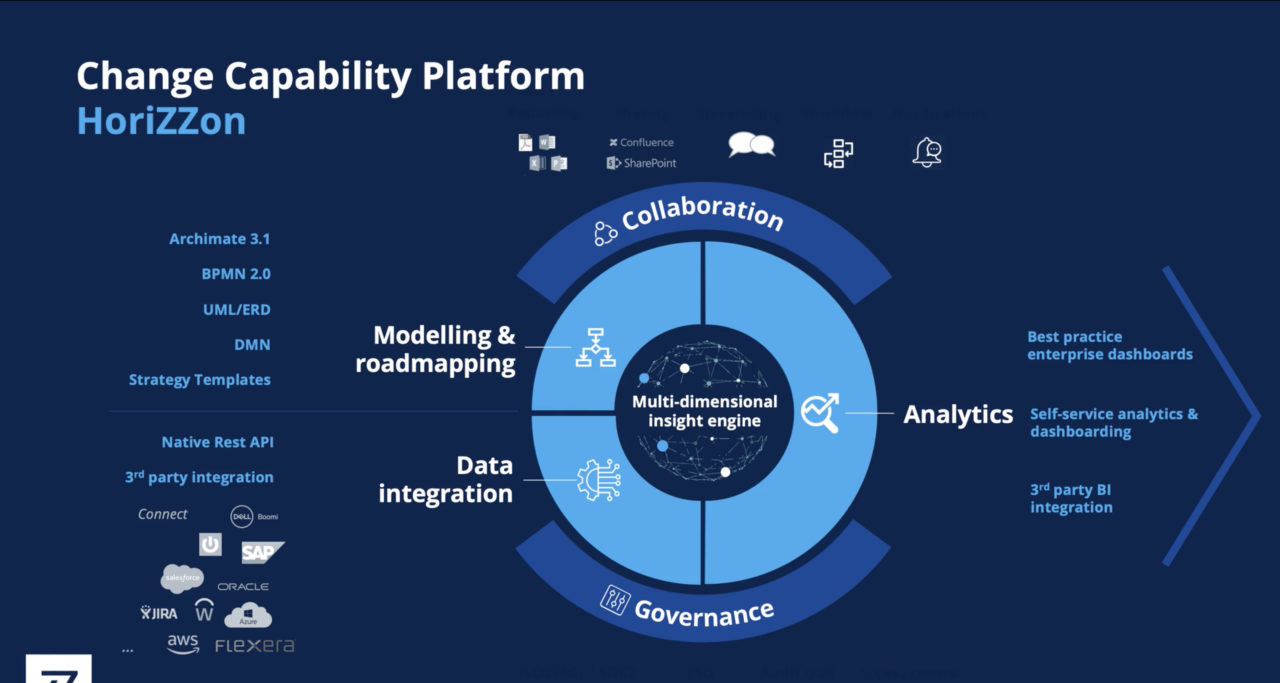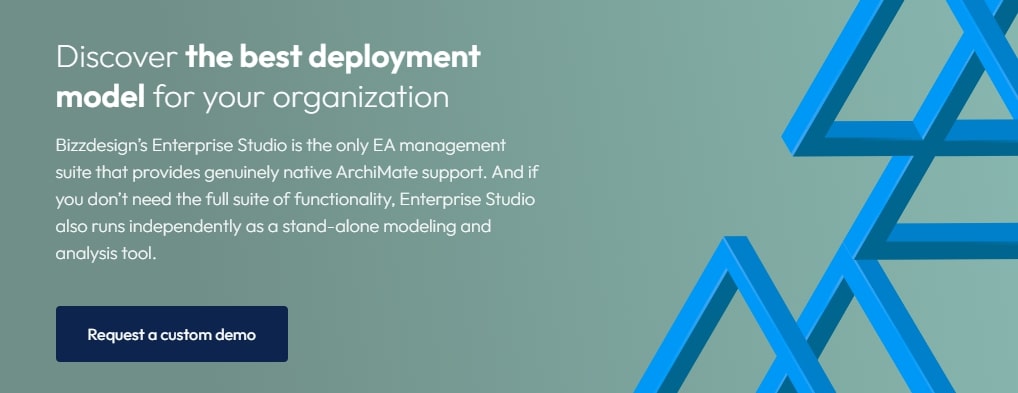The Significance of EA in Businesses
EA is a holistic approach that aligns an organization’s business strategies with its IT infrastructure. It establishes standard architectures to ensure consistency, control, and compliance across all aspects of the organization.
The importance of EA cannot be overstated. By providing a clear understanding of how different elements interact within an organization, EA enables effective decision-making processes and identifies areas for improvement or optimization while ensuring resources are aligned with strategic goals.
One key role is bridging the gap between business objectives and IT capabilities. This alignment enhances efficiency and effectiveness in operations, increases agility in response to market changes, and ensures better utilization of IT resources by directly supporting business goals.
In summary, EA plays a vital role in modern businesses by providing a comprehensive view of how different components work together towards achieving organizational objectives. Its benefits include improved decision-making processes, enhanced efficiency and effectiveness in operations, increased agility in response to market changes, and better alignment between IT resources and business goals.
The Key Elements of
EA revolutionizes the way organizations operate by seamlessly integrating business processes, information systems, data assets, and technology infrastructure. It acts as a dynamic blueprint that orchestrates and empowers these crucial components to work harmoniously towards achieving the ultimate goals of the business. The four primary domains at the core of EA are:
- Business Architecture:
- This domain focuses on understanding the organization’s structure, functions, processes, and capabilities.
- It defines the strategic goals and objectives of the business while identifying key stakeholders.
- Business architecture helps identify areas for improvement or optimization within the organization.
- Application Architecture:
- Application architecture deals with designing and managing software applications used by an organization.
- It includes defining application portfolios, their interdependencies, interfaces, and integration points.
- Application architecture ensures that applications are aligned with business requirements while optimizing resource utilization.
- Data Architecture:
- Data architecture involves organizing, structuring, storing, and governing an organization’s data assets.
- It defines data models along with standards for data storage formats, structures, definitions, naming conventions, as well as policies for data access control.
- Data architecture enables effective management of enterprise-wide data assets to ensure consistency, accuracy, and integrity across different systems.
- Technology Architecture:
- Technology architecture focuses on selecting appropriate technologies to support business operations and achieve organizational goals.
- It includes hardware infrastructure (servers, networks), software platforms (operating systems, databases), and other IT resources required to run applications effectively.
- Technology architecture ensures that technology investments align with business needs while providing scalability, reliability, and security.
These four domains work closely together to form a cohesive system known as EA. They provide a comprehensive view of how different aspects of an organization work together to achieve desired outcomes.

The Advantages of Implementation
Implementing enterprise architecture in your business can greatly contribute to its overall success. Let’s explore the key advantages:
- Enhanced Decision-Making: Gain a comprehensive view of your organization and understand how different components interact. Make well-informed decisions based on accurate and up-to-date information, leading to better outcomes.
- Streamlined Efficiency and Effectiveness: Align processes, technology, and resources to streamline operations and eliminate redundancies. Deliver products or services with improved efficiency.
- Adaptability to Market Changes: Stay competitive by quickly responding to market changes with a clear roadmap for implementing new technologies or adjusting strategies.
- Alignment of IT Resources with Business Goals: Bridge the gap between IT capabilities and strategic objectives. Ensure that IT investments align with broader goals for more effective resource use.
- Ensuring Security & Compliance: Prioritize security measures while maintaining compliance with industry standards by incorporating security considerations into every aspect of your infrastructure. Implementing enterprise architecture brings significant benefits that positively impact decision-making, efficiency, adaptability, alignment, security, and compliance – providing a solid foundation for sustainable growth in today’s dynamic business environment.
Comparative Analysis of Enterprise Architecture Frameworks
Enterprise architecture frameworks revolutionize the way we design and implement enterprise architectures. They provide a strategic blueprint, guiding organizations to align their business strategies seamlessly with their IT infrastructure. In this section, we will explore popular frameworks such as TOGAF, Zachman, and FEAF to empower you in making an informed decision. Get ready for a game-changing journey into the world of enterprise architecture!
- Overview of Popular Frameworks:
- TOGAF (The Open Group Architecture Framework): TOGAF is widely adopted for its comprehensive approach in addressing business needs while ensuring alignment with IT capabilities.
- Zachman Framework: This framework focuses on capturing different perspectives or “views” of an organization’s architecture through a matrix-based structure.
- FEAF (Federal Enterprise Architecture Framework): Developed by the U.S. federal government to improve interoperability among federal agencies.
- Pros and Cons:
- TOGAF:
- Pros:
- Well-established framework with extensive documentation
- Provides a step-by-step methodology for creating architectures
- Offers flexibility in tailoring the framework to specific organizational needs
- Cons:
- Can be complex and overwhelming for smaller organizations
- Requires significant time and resources for implementation
- Pros:
- Zachman Framework:
- Pros:
- Emphasizes multiple perspectives to capture all relevant architectural information
- Helps stakeholders understand complex relationships within an organization
- Cons:
- Lacks detailed guidance on implementation processes
- May require additional customization based on organizational requirements
- Pros:
- FEAF:
- Pros:
- Designed specifically for the U.S. federal government, ensuring compliance with regulatory requirements
- Promotes interoperability and information sharing among federal agencies
- Cons:
- May not be as applicable to non-government organizations
- Limited adoption outside of the federal sector
- Pros:
- TOGAF:
- Factors to Consider When Choosing a Framework: When selecting an enterprise architecture framework, numerous factors must be taken into account. These include the size and complexity of your organization, adherence to industry standards and compliance regulations, scalability and flexibility requirements, as well as the availability of resources. The choice of the right enterprise architecture framework is pivotal in shaping your organization’s architectural design. It is imperative that you meticulously assess each option based on your specific organizational needs before making a decision.
The Role of an Enterprise Architect
Effective alignment of IT infrastructure with overall business strategies is crucial for businesses to thrive. Enterprise architecture frameworks play a pivotal role in achieving this synergy. In this section, we will delve into three popular and powerful frameworks – TOGAF, Zachman framework, and FEAF – exploring the key factors to consider when selecting the perfect fit for your organization. Get ready to unlock the potential of your IT landscape!
- Overview of Popular Frameworks:
- TOGAF: Developed by The Open Group, TOGAF is a widely used enterprise architecture framework that provides a comprehensive approach for designing and governing enterprise information technology architecture.
- Zachman framework: Created by John Zachman in the 1980s, this framework focuses on capturing different perspectives or “views” of an enterprise’s architecture through a matrix-based structure.
- FEAF: Specifically designed for U.S. federal government agencies, FEAF aims to improve efficiency and effectiveness through standardization and consolidation.
- Pros and Cons:
- TOGAF:
- Pros:
- Well-established industry standard
- Comprehensive coverage across all domains
- Cons:
- Can be complex to implement fully
- Requires significant time investment for training
- Pros:
- Zachman framework:
- Pros:
- Provides clear structure for organizing architectural artifacts
- Cons:
- Limited guidance on implementation details
- May require customization based on specific organizational needs
- Pros:
- FEAF:
- Pros:
- Tailored specifically for federal government agencies
- Cons:
- May not be suitable for non-government organizations
- Limited adoption outside of the federal sector
- Pros:
- TOGAF:
- Factors to Consider when Choosing a Framework: When selecting a framework, it’s important to consider your organization’s goals and objectives, as well as the scope and complexity of your business. Additionally, look at industry standards and best practices while assessing resource availability such as budget and skilled personnel. By carefully evaluating these factors, you can select an enterprise architecture framework that best suits your organization’s needs.
Case Studies: Successful Enterprise Architecture Implementation
In this section, we’ll delve into real-world examples of businesses that have successfully implemented enterprise architecture and the valuable lessons we can learn from their experiences. These case studies showcase the tangible benefits and value that enterprise architecture brings to organizations.
- Company A: Streamlining Operations for Efficiency Global manufacturing giant, Company A, faced the daunting challenge of managing their intricate supply chain operations. But they didn’t back down. Instead, they harnessed the power of an enterprise architecture framework to revolutionize their processes and supercharge efficiency. With eagle-eyed analysis of their business goals and IT infrastructure, Company A’s brilliant enterprise architects pinpointed areas ripe for technological automation and resource optimization.
- They crafted a masterful roadmap that seamlessly integrated systems across departments, fostering collaboration and eliminating wasteful duplication. The result? Cost savings galore as resources were utilized with laser precision while productivity soared throughout the organization. Remember this valuable lesson: Aligning your business objectives with your IT capabilities is absolutely essential for a triumphant enterprise architecture implementation.
- Company B: Enhancing Customer Experience through Integration Company B, a leading retail brand, understands the importance of delivering an exceptional customer experience across all channels. That’s why they embraced enterprise architecture as a powerful tool. By integrating their business processes and technology infrastructure, Company B’s enterprise architects created a comprehensive view of customer data at every touchpoint.
- This empowered them to personalize marketing campaigns based on individual preferences and maintain consistent messaging throughout the entire customer journey. The results were remarkable: increased customer satisfaction levels and higher conversion rates both online and offline. Company B’s strategic use of enterprise architecture principles truly made a difference in enhancing their customers’ experiences. Key Lesson: Enterprise architecture facilitates effective integration between different systems for delivering exceptional customer experiences.
- Company C: Driving Innovation through Agile Practices In the cutthroat tech industry, Company C knows that innovation is the key to success. They realized that traditional methods weren’t cutting it. So, they turned to enterprise architecture. Their architects brought in a collaborative approach to software development. With rapid prototyping and continuous feedback, they seamlessly integrated new technologies.
- This shift in mindset made all the difference. Company C sped up their product launches without sacrificing quality. And it sparked a culture of innovation, where employees could contribute ideas and drive positive change. Enterprise architecture is the catalyst for organizational agility and a breeding ground for innovation. It empowers iterative development, fueling progress and driving change.
How to Kickstart in Your Business
Understand the importance of enterprise architecture in businesses. Revolutionize your business with enterprise architecture (EA). Follow these essential steps:
- Define goals: Outline what you want to achieve with EA, identifying specific challenges and outcomes.
- Assess current state: Evaluate your IT infrastructure, systems, processes, and organizational structure in relation to your goals.
- Establish an EA team: Assemble experts in business analysis, technology architecture, data management, and project management.
- Develop an EA framework: Choose a suitable framework like TOGAF or Zachman that aligns with your needs.
- Create an architectural vision: Define how EA will support overall business strategy and goals.
- Prioritize initiatives: Focus on projects aligned with short-term wins and long-term objectives for efficiency improvement, cost reduction, customer experience enhancement, or innovation drive.
- Implement iterative improvements: Make small but meaningful changes over time based on evolving needs for continuous feedback and adjustment.
- Communicate & engage stakeholders: Regularly update stakeholders while addressing concerns or resistance.
- Monitor & measure success:Set metrics to track impact such as cost savings or customer satisfaction levels regularly reviewing them. Revamp your business through the power of enterprise architecture!
Visit the website.







